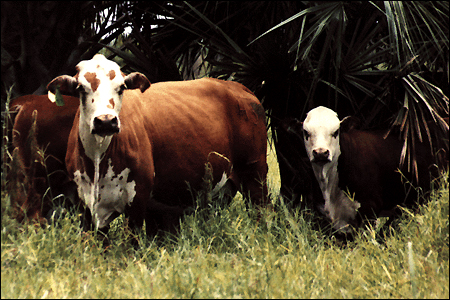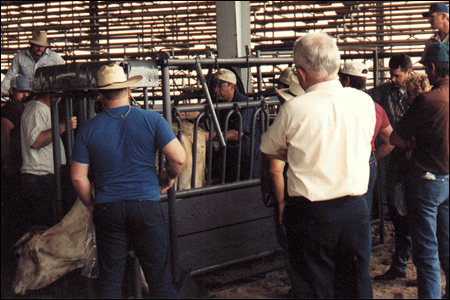- Return to Article Of The Month index
South Florida Beef Industry's Challenges for 2000 and Beyond
February 2000
Doug Mayo - Polk County Extension, Livestock Agent
Will you be able to stay in the cattle business in the 21st Century?
I see a number of challenges facing South Florida beef cattle producers over the next ten years and beyond. The number one problem is going to be dealing with urbanization and the regulation that comes with higher and higher demands on natural resources. The second challenge I foresee is the fight for profitability with the need for improved efficiency to stay afloat in an urbanizing area. Another problem cattlemen will face is producing more pounds of beef on fewer acres as land values rise and families struggle to stay in the cattle business.

Braford Pair on Limpograss Pasture at Deseret
Urbanization
In Polk County alone, 70,000 people moved in last year with 80% of this growth occurring outside of the incorporated communities. That means more agricultural land out of production, more demand for county services and also a rise in property taxes. In a recent agriculture economic impact study of Polk County, it was determined that for every tax dollar agricultural operations paid they received 8 cents worth of services from the county in return. But, for every $1 homeowners paid in taxes they received $1.89 worth of services. That means agriculture provides the funding for our growing urban population, not to mention the water and other resources needed. Currently 42% of Polk County's land area is being utilized for agriculture, but that percentage is shrinking. This will make involvement in your county Cattlemen's Association and Farm Bureau even more important. No longer can producers sit back in politics. Ranchers need to take an active role as an organized group.
Efficiency
Finally, cattle prices have started to rise. I anticipate at least three years of improved prices, but we will see lower calf prices in 2004-06 if the ten year cycle continues. Cattlemen in Florida will continue to face discounts for freight and Brahman breeding. In order to remain in business, ranchers are going to have to look at ways of becoming more efficient and improving the calves produced. The days of year round breeding, no records and low management are coming to a close.
There are several ways to improve efficiency. One of the simplest and most effective is annual pregnancy testing and using a 90-120 day controlled breeding season. This does not require extensive record keeping since cattle are sorted through the chute following weaning. If cows are open they can either be sold or branded and sorted to a low maintenance pasture. The shorter breeding season means that all of the herd is in the same stage of production. All of the herd can be fed correctly at the right time. This way you don't have dry cows getting fat wasting feed or wet cows getting thin from a feed shortage. Also, labor is reduced because all of the calves are weaned and worked at the same time.

One of the simplest and most effective is annual pregnancy testing and using a 90-120 day controlled breeding season. If you would like to learn how to apply these management practices, contact your county livestock agent about attending the Reproductive Management School April 24-28.
At some point, however, to truly become efficient, production and financial records must be developed. This does not mean that you have to number every cow and calf, but at least keep track of cattle sales, inventory at breeding, pregnancy rates, average weaning weights, body condition at weaning, timing and amount of feeding, fertilizer and pasture expenses, labor costs and equipment and facility purchases and repairs. All this information can be used over time for total ranch management and developing ranch goals and objectives for the future. If you don't know where you are it's hard to know what to improve.
Pasture Improvement
Even with improved cattle efficiency, cattlemen will have to get more out of their pastures. Mole crickets, soda apple, smutgrass, cogongrass are steadily getting worse in this area and if this trend continues pasture yields will decline even more. Currently we do not have a very good control for mole crickets. The strategy that has been successful is planting stargrass. This is the one grass variety that is bothered very little by mole crickets. Bermuda grasses are not as hampered by them as bahia but can still be damaged. Soda apple and smutgrass can be controlled chemically with the proper management plan. They are not, however, weeds that are easy to eliminate. The worst weed to eliminate is cogongrass. Spraying with roundup in the fall, along with discing, burning and mowing through the growing season will slowly reduce the amount of cogongrass, but with the plant's tremendous rhizome system there is no quick fix. Plus, this grass is a tremendous seed producer making it very difficult to eliminate if your neighbors are not controlling it as well.
The best solution I see for getting more out of your pastures is to diversify varieties of grasses to have a longer grazing window. Limpograss (hemarthria) and Rhodesgrass have 30-35% of there growth from October through February. Rhodesgrass also has a much higher feeding value than bahia in the fall of the year. Limpograss can be stockpiled in late summer because of its high digestibility and then grazed off and on through most of the winter and early spring. Stargrass has a much higher yield than bahia and grows a little longer in the fall. This grass can also be used for hay production and has higher protein levels than bahia when harvested before maturity. Bermudagrasses are better adapted for the dryer soils and provide higher yields and quality of hay than bahia. Certainly we will probably always have a major portion of our pastures in Bahia, but other grasses can extend the time when fresh grass is available, provide higher quality hay and possibly allow for higher stocking rates. The other thing that can extend the yield and quality of fall pastures is aeschynomene, a fall legume which is high in protein and adds nitrogen to the soil in bahia pastures. The final keys to improving what we get from pastures is fertilization and grazing management. No matter what species of grass you choose, timely, adequate fertilization and rotational grazing improves the yield by as much as 20-30%.

